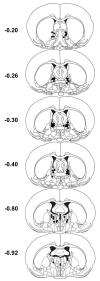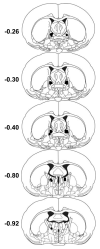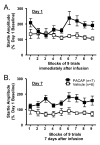Chronic stress increases pituitary adenylate cyclase-activating peptide (PACAP) and brain-derived neurotrophic factor (BDNF) mRNA expression in the bed nucleus of the stria terminalis (BNST): roles for PACAP in anxiety-like behavior
- PMID: 19181454
- PMCID: PMC2705919
- DOI: 10.1016/j.psyneuen.2008.12.013
Chronic stress increases pituitary adenylate cyclase-activating peptide (PACAP) and brain-derived neurotrophic factor (BDNF) mRNA expression in the bed nucleus of the stria terminalis (BNST): roles for PACAP in anxiety-like behavior
Abstract
Exposure to chronic stress has been argued to produce maladaptive anxiety-like behavioral states, and many of the brain regions associated with stressor responding also mediate anxiety-like behavior. Pituitary adenylate cyclase activating polypeptide (PACAP) and its specific G protein-coupled PAC(1) receptor have been associated with many of these stress- and anxiety-associated brain regions, and signaling via this peptidergic system may facilitate the neuroplasticity associated with pathological affective states. Here we investigated whether chronic stress increased transcript expression for PACAP, PAC(1) receptor, brain-derived neurotrophic factor (BDNF), and tyrosine receptor kinase B (TrkB) in several nuclei. In rats exposed to a 7 days chronic variate stress paradigm, chronic stress enhanced baseline startle responding induced by handling and exposure to bright lights. Following chronic stress, quantitative transcript assessments of brain regions demonstrated dramatic increases in PACAP and PAC(1) receptor, BDNF, and TrkB receptor mRNA expression selectively in the dorsal aspect of the anterolateral bed nucleus of the stria terminalis (dBNST). Related vasoactive intestinal peptide (VIP) and VPAC receptor, and other stress peptide transcript levels were not altered compared to controls. Moreover, acute PACAP38 infusion into the dBNST resulted in a robust dose-dependent anxiogenic response on baseline startle responding that persisted for 7 days. PACAP/PAC(1) receptor signaling has established trophic functions and its coordinate effects with chronic stress-induced dBNST BDNF and TrkB transcript expression may underlie the maladaptive BNST remodeling and plasticity associated with anxiety-like behavior.
Figures







Similar articles
-
PAC1 receptor antagonism in the bed nucleus of the stria terminalis (BNST) attenuates the endocrine and behavioral consequences of chronic stress.Psychoneuroendocrinology. 2014 Sep;47:151-65. doi: 10.1016/j.psyneuen.2014.05.014. Epub 2014 May 27. Psychoneuroendocrinology. 2014. PMID: 25001965 Free PMC article.
-
Roles for pituitary adenylate cyclase-activating peptide (PACAP) expression and signaling in the bed nucleus of the stria terminalis (BNST) in mediating the behavioral consequences of chronic stress.J Mol Neurosci. 2010 Nov;42(3):327-40. doi: 10.1007/s12031-010-9364-7. Epub 2010 Apr 20. J Mol Neurosci. 2010. PMID: 20405238 Free PMC article. Review.
-
The Effects of Prior Stress on Anxiety-Like Responding to Intra-BNST Pituitary Adenylate Cyclase Activating Polypeptide in Male and Female Rats.Neuropsychopharmacology. 2017 Jul;42(8):1679-1687. doi: 10.1038/npp.2017.16. Epub 2017 Jan 20. Neuropsychopharmacology. 2017. PMID: 28106040 Free PMC article.
-
Regulation of bed nucleus of the stria terminalis PACAP expression by stress and corticosterone.J Mol Neurosci. 2014 Nov;54(3):477-84. doi: 10.1007/s12031-014-0269-8. Epub 2014 Mar 12. J Mol Neurosci. 2014. PMID: 24614974 Free PMC article.
-
Pituitary adenylate cyclase activating polypeptide (PACAP), stress, and sex hormones.Stress. 2017 Sep;20(5):465-475. doi: 10.1080/10253890.2017.1336535. Epub 2017 Jun 14. Stress. 2017. PMID: 28610473 Free PMC article. Review.
Cited by
-
Repeated variate stress in male rats induces increased voiding frequency, somatic sensitivity, and urinary bladder nerve growth factor expression.Am J Physiol Regul Integr Comp Physiol. 2013 Jul 15;305(2):R147-56. doi: 10.1152/ajpregu.00089.2013. Epub 2013 May 8. Am J Physiol Regul Integr Comp Physiol. 2013. PMID: 23657640 Free PMC article.
-
Activation of MEK/ERK signaling contributes to the PACAP-induced increase in guinea pig cardiac neuron excitability.Am J Physiol Cell Physiol. 2016 Oct 1;311(4):C643-C651. doi: 10.1152/ajpcell.00164.2016. Epub 2016 Aug 3. Am J Physiol Cell Physiol. 2016. PMID: 27488668 Free PMC article.
-
Behavioral methods to study anxiety in rodents.Dialogues Clin Neurosci. 2017 Jun;19(2):181-191. doi: 10.31887/DCNS.2017.19.2/wcarlezon. Dialogues Clin Neurosci. 2017. PMID: 28867942 Free PMC article. Review.
-
The functional heterogeneity of PACAP: Stress, learning, and pathology.Neurobiol Learn Mem. 2023 Sep;203:107792. doi: 10.1016/j.nlm.2023.107792. Epub 2023 Jun 25. Neurobiol Learn Mem. 2023. PMID: 37369343 Free PMC article. Review.
-
Parabrachial Pituitary Adenylate Cyclase-Activating Polypeptide Activation of Amygdala Endosomal Extracellular Signal-Regulated Kinase Signaling Regulates the Emotional Component of Pain.Biol Psychiatry. 2017 Apr 15;81(8):671-682. doi: 10.1016/j.biopsych.2016.08.025. Epub 2016 Aug 29. Biol Psychiatry. 2017. PMID: 28057459 Free PMC article.
References
-
- Agarwal A, Halvorson LM, Legradi G. Pituitary adenylate cyclase-activating polypeptide (PACAP) mimics neuroendocrine and behavioral manifestations of stress: Evidence for PKA-mediated expression of the corticotropin-releasing hormone (CRH) gene. Brain Research Molecular Brain Research. 2005;138:45–57. - PMC - PubMed
-
- Arimura A. Perspectives on pituitary adenylate cyclase activating polypeptide (PACAP) in the neuroendocrine, endocrine, and nervous systems. Japanese Journal of Physiology. 1998;48:301–331. - PubMed
-
- Braas KM, May V. Pituitary adenylate cyclase-activating polypeptides directly stimulate sympathetic neuron neuropeptide Y release through PAC(1) receptor isoform activation of specific intracellular signaling pathways. Journal of Biological Chemistry. 1999;274:27702–27710. - PubMed
-
- Casada JH, Dafny N. Restraint and stimulation of bed nucleus of the stria terminalis produce similar stress-like behaviors. Brain Res Bull. 1991;27:207–212. - PubMed
Publication types
MeSH terms
Substances
Grants and funding
LinkOut - more resources
Full Text Sources
Other Literature Sources
Medical
Molecular Biology Databases

